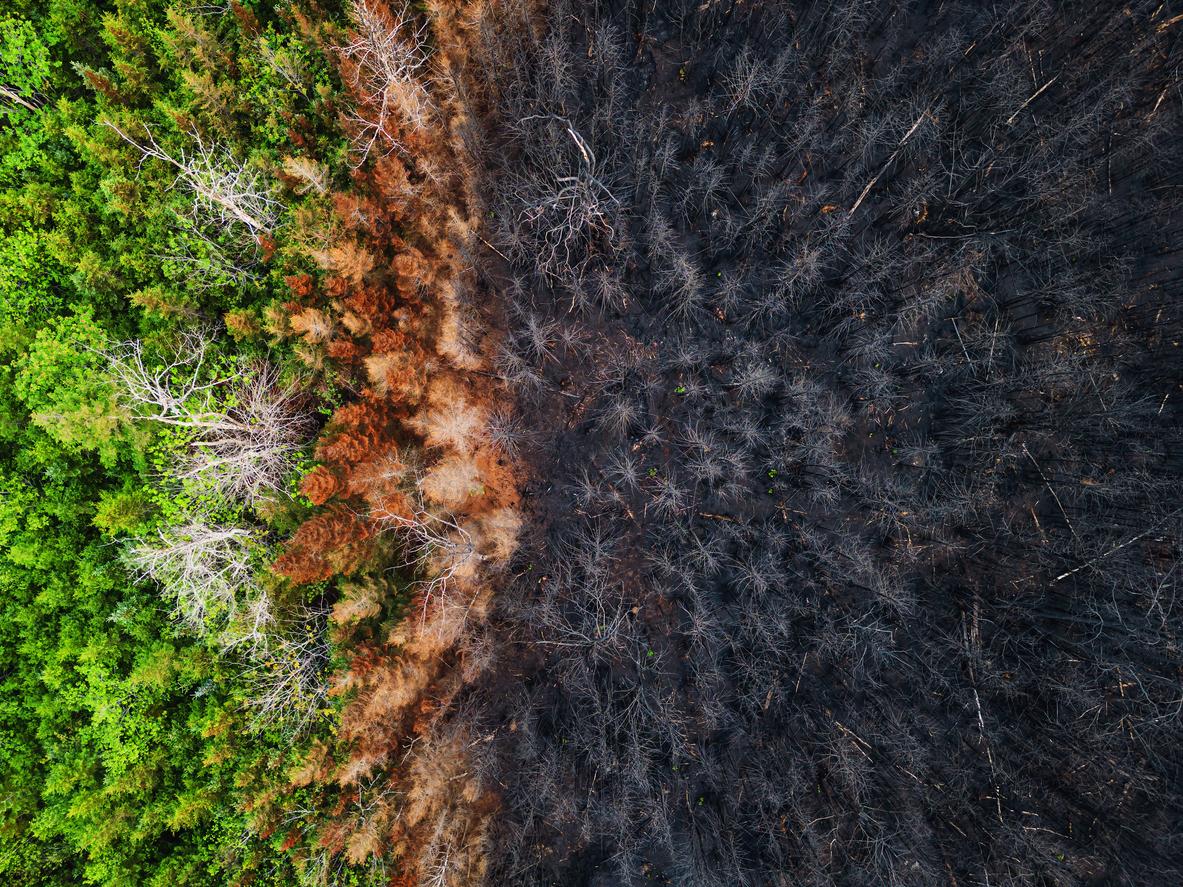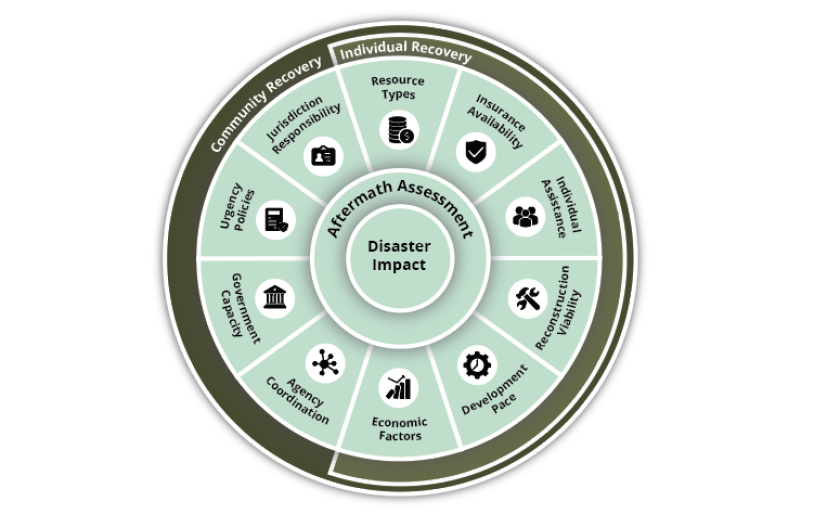Envisioning Holistic, Long-term Wildfire Recovery
Evidence for Policy Fellow Katie Simmons seeks to help local governments and agencies enhance the pace and scale of wildfire recovery

Katie Simmons, Deputy Chief Administrative Officer for Butte County in Northern California, spent 2024 leaning into the intersection of data and storytelling. As part of SIL’s year-long Evidence for Policy fellowship, Katie shaped Three Fire Mountains (Work in Progress), a resource which describes her simultaneous experiences as a wildfire recovery professional and wildfire survivor. It also details the ways that federal- and state-run programs fall short in meeting community needs on the heels of disaster. Katie sat down with SIL’s Director of Innovation and Partnerships Hana Passen to talk through what the fellowship helped her realize.
Hana Passen: You started your fellowship thinking you’d develop a model for sustainable wildfire recovery - particularly with respect to housing. How and why did your focus change over the course of the fellowship?
Katie Simmons: As a professional working in the field of wildfire recovery, I wanted to simplify and streamline the process to increase the pace and scale of recovery. A faster, more complete recovery process reduces the risk of prolonged displacement and disaster-caused homelessness, and therefore suffering. But, what I discovered as I started to research recovery is that no two agencies define it the same and so it’s difficult to measure and report on progress.
The industry of catastrophic wildfire recovery in populated areas is relatively new. To date, the deadliest wildfire in California history happened in Butte County in 2018. The recent fires in Los Angeles may be the most destructive in California history. Looking at the complexity of wildfire recovery six years post-Camp Fire, I can see how important it is to define the basics because survivors, local government, and the State and federal government may all have different expectations.
I also found that while it’s possible to create a model to measure community viability using quantifiable data, so many recovery inputs are intangible (personal choices that defy the odds and available resources, for example) which make outcomes less predictable. Federal, State, and local governments work together during recovery, but the communication is often limited to programs and processes rather than recovery itself. I began to lean more toward the need for a system designed to support the variabilities inherent in long-term recovery than a predictive model for recovery outcomes.
More than anything, what I found over the course of the fellowship is that I wanted to express the complexity and hardship in recovery because I believe these are common threads running through every disaster and recovery experience. It may be difficult to make every recovery process easier, but we can support each other through the trauma in an effort to reduce overall suffering. There’s no reason counties and cities within California and other wildfire-impacted communities should experience recovery alone.
Hana: In your fellowship paper, you detail the ways that wildfire recovery programs, while being incredibly data-driven, fail to account for the extremely local context of disasters. What are some of the consequences of this one-size-fits-all approach to disaster recovery?
Katie: In the case of Camp Fire multi-family housing grants coming from the federal government, these grants are funding the construction of housing developments in urban areas of Butte County, not necessarily in rural areas where the housing stock was lost.
Wildfire often destroys and damages housing in rural, remote communities where there is limited to no infrastructure to support dense, multi-family housing. These grants have to fund projects that are feasible and competitive for other State tax credits that require proximity to transportation and amenities; therefore, these developments are often situated in urban areas where there are connections to sewer, municipal water, bus stops, and grocery stores.
As a result, these funds are directly invested into urban areas as infill projects rather than housing recovery projects in the burn scar. Wildfire survivors often prefer to recover in place – where their home was lost – not relocate to urban areas where they are disconnected from their land, neighbors, family, and friends. And so, some survivors choose long-term RV living versus moving into an apartment in a nearby city. The construction of what I call displacement housing – housing that displaces survivors – can lead to disaster-caused homelessness for people who choose to remain on their land in substandard housing conditions.
Hana: Butte County is at the forefront of wildfire recovery after two of the worst fires in U.S. history, with new fires happening every year - which makes Butte County the de-facto “institutional memory” for how to recover from wildfire. What are the biggest challenges of this model of sharing information?
Katie: I consider wildfire recovery to be the largest, most consequential industry passed down through oral history. With the exception of federal and State recovery manuals that are dense, heavy, and meant to be applicable to multiple kinds of disasters, there is no single resource or site for sharing disaster recovery knowledge.
When disaster occurs, local governments and organizations get in touch with each other personally and pass along bits of information needed for recovery, literally oftentimes sitting side by side. Right now, first responders from Butte County are in Los Angeles County aiding with their wildfires. This is a meaningful and important aspect of response and recovery – human connection and encouragement with some relevant “hands-on know how.” While response is a well-oiled machine, it is not sustainable for every community that has experienced disaster to send recovery workers to a newly destroyed community. Also, without a place to put and store knowledge and skills, institutional memory is permanently lost when recovery workers burn out, retire, or leave the profession.
Long-term recovery funding is granted on an incident-by-incident basis. Action Plans for the use of these funds are newly created by the State with each Congressional appropriation. Though there are some similarities between programs and funding sources, the experience of using these funds and applying these programs is different with each disaster. And each disaster is different – different in both cause and effect. This makes it challenging for local governments to build up capacity and knowledge when each disaster brings a different set of impacts and a different recovery process that has to layer upon the last one.
Designing a system for long-term recovery that centralizes knowledge, accounts for variables, and is repeatable and scalable, can guide federal, State, and local governments through the process, reducing the painful reinvention required by each disaster.
It is human nature to reach out to others who are suffering, particularly when one has skills and experience to ease the suffering. But there has to be a system beyond a desire to help that is not contingent upon the availability and proximity of resources. As much as firefighters know how to frame up their response to each disaster, local governments must know how to frame up their response to each recovery.
Hana: As part of your fellowship, you’ve created a ‘recovery triage’ (pictured below) for other wildfire professionals to begin to use to take stock of what comes next after, to use your words, “the worst has already happened”. How do you envision this being helpful to people working in recovery?
Katie: Much like a fellow professional arriving to triage disaster through words of advice, the recovery triage is meant to be a simplified document that can be used time and time again at the outset of wildfire recovery, once the disaster and aftermath impacts are known. The recovery triage asks a series of questions to help local governments and agencies begin to size up available resources for individual and community recovery. Individual recovery is the restoration of each home lost to fire, and community recovery is the restoration of the built environment following fire – parks, streets, signs, libraries, local stores, etc.

Local governments might use all the questions to understand their roles and responsibilities in aiding individual and community recovery. Local nonprofits might focus on individual recovery, and should be able to see the whole picture of recovery to understand where and how to plug in most effectively given the resources at hand.
There are different inputs into recovery such as types of funding: charitable, settlements, federal loans, insurance proceeds, etc. Understanding why, how, when, and where these funds might be used helps identify gaps in resources for individual and community recovery.
The recovery triage can also be used as a planning tool pre-disaster, to give an indication of what data is needed to frame up and shore up vulnerabilities before the worst occurs. If and when disaster occurs, the primary indicators for the pace and scale of recovery will be known and can be addressed right away.
Hana: Let’s imagine for a moment that you had the power to change one thing about how wildfire recovery is practiced - this could be by anyone in the field, at any level (federal, state, local). What change would have the biggest impact on a community’s ability to recover after a wildfire?
Katie: I would invite the leaders of FEMA, Cal OES, and local governments in California impacted by catastrophic wildfire in the last decade to meet. I would pitch the idea of designing a system for long-term recovery that aligns and coordinates the roles and responsibilities of each level of government.
With many of the rules and regulations at odds with each other, we’d have the opportunity to think through the entire system in a safe and contained way. Right now, with each agency working independently, the processes are tested on communities in their most vulnerable states – after the worst has occurred. This has the effect of re-traumatizing communities after a disaster.
Collectively, we should recognize the stakes of this grand experiment, and decide to put some intention, care, and consideration behind our efforts to reduce the experience of trauma for survivors and the recovery workforce, and shore up the cracks that survivors and whole communities fall through during recovery. Disaster is painful enough, recovery shouldn’t add to the pain and prolong the suffering. In Butte County alone, only 5% of the housing stock lost to the North Complex Fire in 2020 has been reconstructed. If the pace and scale of recovery generally peak 5 years post-disaster, we may never see communities return to their pre-disaster states. A resilient, sustainable system of long-term recovery is needed for both rural and urban disaster impacts in California before more communities are lost to wildfire for good.
For wildfire recovery professionals who are largely self-taught and/or guided by a temporary helping hand, a long-term recovery system would bring policy predictability, established communication channels between all levels of government, and mechanisms to work out differences and hardships before they impact individuals and communities.
Reducing the misalignments between federal and State policies that create conflict at the local level, for example, would reduce the overall friction of recovery. Good communication would allow for greater, faster collaboration during the inevitable pain points between agencies during recovery like expenditure timeframes. Any improvements in the recovery process will lower the risk of re-traumatization which will, without question, decrease suffering and hardship for survivors and the workforce during recovery.
I am 100% certain we can do better than this.
